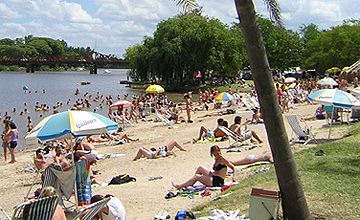Even at the access to the district, Chajarí reflects the politeness of its people when it comes to welcoming visitors. Upon our arrival, we crossed the arch featuring modern lines located at the entrance of the city. We had our first approach of the surroundings at the tourist information office. Immediately, we were ready to go around the downtown and discover its mot representative corners.
Many buildings, such as the Town Hall or Saint Rose's Church, synthesize the history and architecture of the early twentieth century, when the city began to be shaped around a railway station.
We went around its squares called Urquiza, Libertad and San Martín, which boast gorgeous gardens very popular among the locals due to their shade and shelter on the hot summer afternoons.
City tour around Chajarí, A City of Friends
We visited two of its most emblematic museums: Camila Quiroga Historic and Regional Museum and Ivy marä Ey Ethnographic Museum. The former is located at the birthplace of the Argentinian dramatic leading actress and treasures valuable elements that give evidence of the colonial and criollo history of Chajarí. The latter is housed by the old railway station and rescues the native Guaraní culture.
The word “chajarí” stands for a bird species that dwells near the local creeks. A sculpture known as "Dreams and Hopes" is located in a small circular square at the intersection of 9 de Julio and 25 de Mayo Streets. The chajá spreading its wings wide open is the main allegory of the water fountain that is lit at night and contributes to the magic of the dancing waters.
The bicycle is one of the most usual means of transportation in the city. Taking a nap, on the other hand, is a sacred habit for the authentic settlers of Chajarí, maybe because of tradition, the heat or just to make nights last longer while having a chat with friends.
The most remarkable recreation point in the city during hot days lies very close to the center: the municipal beach on the Salto Grande reservoir. The lush nature, the beaches made of sand and pebbles, the great number of nautical sports available represent the most important attractions. This place has everything visitors need to spend a day with the family or else camp.
For a while, Chajarí has taken pride in its hot spring resort, with waters that emerge from the land at very high temperature and with exceptional therapeutic properties. This is an excellent option in the hot spring circuit in Entre Ríos.
At Chajarí, the warmth of its people is enjoyed all around.
Mónica Pons
Pablo Etchevers























